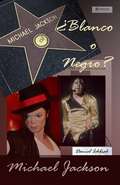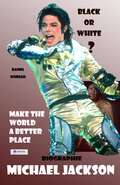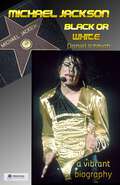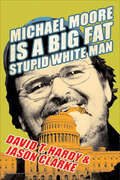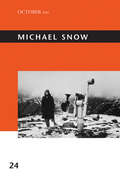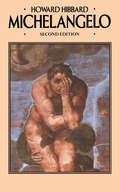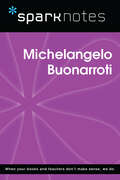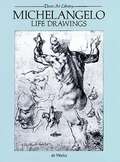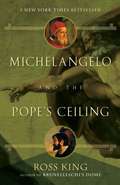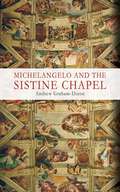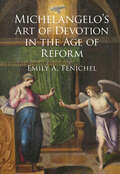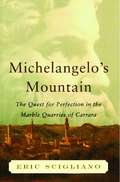- Table View
- List View
Michael Jackson ¿Blanco o Negro?: Michael Jackson ¿Blanco o Negro?
by Daniel IchbiahDescripción De todas las estrellas que aparecieron después de muchas décadas, Michael Jackson era la más fascinante, esa que nos lleva casi que a hacerle un análisis inmediato. Con un increible talento, capaz de poner en escena espectáculos de una extraña naturaleza, de componer éxitos memorables, de transformar su cuerpo de una manera horrorosa, Michael Jackson ha cautivado el público por sus cualidades artísticas. En contraste, ese mismo público ha debido aceptar las excentricidades de un personaje inigualable, un tipo de héroe salido de un cuento de hadas, ese quien se ha descarrilado en el camino. Esta historia contendrá lo esencial: ¨ Billy Jean ¨, ¨ Thriller ¨, ¨ Don’t stop till you get enough ¨ y otras canciones que se convirtieron en clásicos los cuales se niegan a desaparecer con el transcurrir del tiempo… Como ha dicho otro maestro del arte, Steven Spielberg: ¨Como él no habrá jamás; un Fred Astaire u otros como Chuck Berry o Elvis Presley, no existirá una persona que se pueda comparar con Michael Jackson.¨ ¨Su talento, su vivacidad y su lado misterioso hacen de él una leyenda...¨
Michael Jackson – Black or White
by Daniel IchbiahVon allen Bühnenstars der letzten Jahrzehnte ist und bleibt Michael Jackson der faszinierendste, derjenige, der ihm wahrsten Sinne des Wortes aus der Reihe tanzt. Ein wahres Talentbündel, fähig, Shows von seltener Qualität zu inszenieren, Hits für die Ewigkeit zu schreiben, seinen Körper im galaktischen Moonwalk zu bewegen, verführte der 'King of Pop' die Öffentlichkeit zunächst mit seiner Genialität als Künstler. Andererseits musste dasselbe Publikum die exzentrischen Spleens einer Kunstfigur akzeptieren; denn fast hätte es den wie aus einem Märchen entstiegenen Helden auf seinem Weg nach oben aus der Bahn geworfen. Was dennoch bleibt, ist die Essenz seines Erfolgs: 'Billy Jean', 'Thriller', 'Don't stop till you get enough' und andere Songs, die zu Klassikern geworden sind und die Zeit überdauern werden... Steven Spielberg, ein anderer Meister seiner Kunst, drückte dies mit folgenden Worten aus: « Genauso wie es nie einen weiteren Fred Astaire oder einen weiteren Chuck Berry oder einen weiteren Elvis Presley geben wird, wird es nie mehr jemanden wie Michael Jackson geben. » « Sein Talent, seine Lebendigkeit und seine geheimnisvolle Seite machen ihn zu einer Legende... »
Michael Jackson, Black or White ?
by Daniel IchbiahA vibrant biography of Michael Jackson, the King of Pop, from his earliest years to his tragic death.
Michael Jackson, Black or White: Biographie De Michael Jackson
by Daniel IchbiahEntre todas as estrelas que surgiram em várias décadas, Michael Jackson permanece a mais fascinante, aquela que mais escapa à análise imediata. Pleno de talento, capaz de encenar espetáculos de rara qualidade, de escrever canções eternamente memoráveis, de mover seu corpo duma maneira desconcertante, desde o início Michael Jackson seduziu o público pelas suas qualidades artísticas. Em contrapartida, esse mesmo público precisou aceitar as excentricidades incomuns dum personagem que resta inclassificável, espécie de herói retirado dum conto de fadas, destrambelhado no caminho. Resulta que a História reterá o essencial : Billy Jean, Thriller, Don’t stop till you get enough e outras canções que se tornaram clássicas, destinadas a resistir ao desgaste do tempo... Como declarou outro mestre em sua arte, Steven Spielberg : « Assim como não haverá jamais outro Fred Astaire, ou outros Chuck Berry ou Elvis Presley, jamais haverá alguém comparável a Michael Jackson. Seu talento, sua vivacidade e seu lado misterioso fazem dele uma lenda... » Este livro conta a vida de Michael : concentra-se nos principais episódios de sua vida e descreve a evolução do cantor. Ele conta o making off de Thriller, o álbum de todos os recordes. Também inclui retratos de Quincy Jones, Janet Jackson e LaToya. Por que um gênio da música pop se tornou um personagem enigmático, em busca de uma identidade paralela?
Michael Jackson: un Artista eccezionale, o un Genio? Elementi di riflessione.
by David Abraham Franck VidiellaAnalizzando la carriera di Michael Jackson, Franck Vidiella mette in dubbio la natura sensitiva del termine di "Genio". Basata su una ricerca che conferma il fatto che i grandi genii sono, quasi totalmente, creativi, brillanti, ostinati e pluri-faccettati, ognuna delle tematiche viene analizzata studiando la carriera della Pop Star, in modo tale da offrire elementi per rispondere alla seguente domanda: Era Michael Jackson un'artista eccezionale o un Genio assoluto? La risposta, come potrete vedere, permette un dibattito appassionato.
Michael LaFosse's Origami Butterflies
by Richard L. Alexander Michael G. LafosseWhimsical, exquisite and fragile, butterflies and moths have enchanted and inspired people for centuries. Origami artist Michael G. LaFosse is no exception. His original butterfly paper-folding techniques are a dramatic new development in origami-which some have hailed as the most important advance in origami since the first paper cranes appeared centuries ago. Hundreds of LaFosse butterflies have been featured in exhibitions around the world and his iconic designs are now eagerly sought and widely imitated by folding enthusiasts everywhere.Michael LaFosse's Origami Butterflies presents 26 original projects from LaFosse's extensive butterfly and moth repertoire, including all his personal favorites. This collection has many rarely-seen designs, and several of the models illustrate new technical and design achievements made possible by the ingenious "LaFosse Origami Butterfly Folding System."These elegant forms-each created from a single square sheet of paper without cutting or glue-showcase the versatility of the folding system. All are deceptively simple, yet provide a solid foundation for creative flights of fancy in the hands of an experienced folder. Clear step-by-step instructions show you how to make literally hundreds of different variations by making small adjustments to a few key folds! Whether dry-folded from recycled candy wrappers or wet-folded from expensive handmade papers, these designs exemplify the best aspects of the paper folder's art today.This exciting new book with accompanying DVD represents the culmination of a lifetime of designing and perfecting the art of origami butterflies. It contains everything you need to create your own unique collection!Butterflies include:A Butterfly for Vanessa GouldThe Butterfly for Robert LangA Butterfly for Eric JoiselA Swallowtail for Guy KawasakiThe Boston ButterflyThe Mudarri Luna Moth
Michael Mann: Kino zwischen Zorn und Einsamkeit
by Holger SchumacherZum ersten Mal widmen sich zehn deutschsprachige Wissenschaftler mit unterschiedlichen Forschungsschwerpunkten dem Gesamtwerk Michael Manns. Dabei werden die Leser*innen zu einer zweifachen Reise eingeladen: Auf einem faszinierenden Tauchgang in die Filmwelt des gefeierten Regisseurs treten zentrale Themen, Figurenkonstellationen, kulturelle Hintergründe und Wirkungseinheiten zutage, die einen völlig neuen Blick auf seine Kunst eröffnen: Wie schafft es Michael Mann seit mehr als 40 Jahren, ein weltweites Publikum zu fesseln und immer wieder aufs Neue in den Kinosaal zu locken? Was verraten seine Filme dadurch über die unbewussten Sehnsüchte, Obsessionen und Widerstände in unserer Kultur? Gleichzeitig entwickelt sich ein spannender Dialog zwischen den verschiedenen Deutungsansätzen: Anhand populärer Kinofilme wie HEAT oder COLLATERAL wecken die wichtigsten Disziplinen - von der Morphologie bis zur Seduktionstheorie - Neugier auf den Facettenreichtum der deutschsprachigen Filmwissenschaft. Auf diese Weise entsteht ein Buch über die Kunst des Films und seiner Interpretation.
Michael Moore Is a Big Fat Stupid White Man
by David T. Hardy Jason ClarkeWatching Michael Moore in action—passing off manipulating facts in Bowling for Columbine, spinning statistics in Stupid White Men and Dude, Where's My Country?, shamelessly grandstanding at the Academy Awards, and epitomizing the hypocrisy he's made a king's fortune railing against—has spurred authors David T. Hardy and Jason Clarke to take action into their own hands. In Michael Moore Is a Big Fat Stupid White Man, Hardy and Clarke dish it back hard to the fervent prophet of the far left, turning a careful eye on Moore's use of camera tricks and publicity ploys to present his own version of the truth.Postwar documentarians gave us the documentary, Rob Reiner gave us the mockumentary, and Moore initiated a third genre, the crockumentary.How, they ask, does Moore pull off a proletarian, "man-of-the-people" image so at odds with his lifestyle as a fabulously wealthy Manhattanite? And how large of an impact do his incendiary, ill-founded polemics have on the growing community that follows him with near-religious devotion? Loaded with well-researched, solidly reasoned arguments, and laced with irreverent wit, Michael Moore Is a Big Fat Stupid White Man fires back at one of the left's biggest targets—politically and literally.
Michael Snow (October Files #24)
by Annette Michelson Kenneth WhiteEssential texts on the work of the influential artist Michael Snow: essays and interviews spanning more than four decades. Few filmmakers have had as large an impact on the recent avant-garde film scene as Canadian Michael Snow (b. 1928). His works in a range of media—film, installation, video, painting, sculpture, sound, photography, drawing, writing, and music—address the fundamental properties of his materials, the conditions of perception and experience, questions of authorship in technologically reproducible media, and techniques of translation through written and pictorial representation. His film Wavelength (1967) is a milestone of avant-garde cinema and possibly the most frequently discussed “structural” film ever made. This volume collects essential texts on Snow's work, with essays and interviews spanning more than four decades.From its earliest issues, October has been a primary interlocutor of Snow's work, and many of these texts first appeared in its pages. Written by such distinguished critics and scholars as Annette Michelson, Hubert Damisch, and Malcolm Turvey, they document Snow's participation in postwar discourses of minimalism, postminimalism, photo-conceptualism, and avant-garde cinema, and examine particular works. Thierry de Duve's essay on linguistics in Snow's work appears alongside Snow's response. The volume also includes other writings by Snow, images from his 1975 work Musics for Piano, Whistling, Microphone, and Tape Recorder, and an interview with the artist conducted by Annette Michelson. Essays and interviewsJean Arnaud, Érik Bullot, Hubert Damisch, Thierry de Duve, Andrée Hayum, Annette Michelson, Michael Snow, Amy Taubin, Malcolm Turvey, Kenneth White
Michael Snow: Lives and Works
by James KingA biography of Canada’s greatest living artist. Michael Snow is rightly recognized as the greatest living Canadian artist, and he is also acknowledged as one of the most significant figures in Canadian art history. In a productive, lengthy career, he has, in a wide variety of genres, asked (and often answered) some of the most vexing and important issues in the history of art. During his career, the notion of what constitutes a work of art has undergone many changes, and he has been in the forefront of defining these changes. In many ways, he is the visual artist as intellectual: his images are vibrant and compelling but so are the ideas behind them. Ultimately, his work is about perception. What do we really see when we look at a work of art? What is the act of looking all about? What exactly is a work of art? Michael Snow: Lives and Works is a personal and intimate portrait of an artist who has helped shaped the face of Canadian art in our time.
Michael Winterbottom: Interviews (Conversations with Filmmakers Series)
by Damon SmithProlific British director Michael Winterbottom (b. 1961) might be hard to pin down and even harder to categorize. Over sixteen years, he has created feature films as disparate and stylistically diverse as Welcome to Sarajevo, 24 Hour Party People, In This World, Butterfly Kiss, and The Killer Inside Me. But in this collection, the first English-language volume to gather international profiles and substantive interviews with the Blackburn native, Winterbottom reveals how working with small crews, available light, handheld digital cameras, radio mics, and minuscule budgets allows him fewer constraints than most filmmakers, and the ability to capture the specificity of the locations where he shoots. In Michael Winterbottom: Interviews he emerges as an industrious filmmaker committed to a stripped-down approach whose concern with outsiders and docu-realist authenticity have remained constant throughout his career. Collecting pieces from news periodicals as well as scholarly journals, including previously unpublished interviews and the first-ever translation of a lengthy, illuminating exchange with the French editors of Positif, this volume spans the full breadth of Winterbottom's notably eclectic feature-film career.
Michaela DePrince: From War-Torn Childhood to Ballet Fame (Movers, Shakers, and History Makers)
by Carrie MyersMichaela DePrince was born in Sierra Leone and grew up in the United States. She rose to fame as a ballet dancer in the late 2000s. Learn more about DePrince's life as a famous ballerina!
Michaelangelo: A Portrait Of The Greatest Artist Of The Italian Renaissance (Y Ser.)
by William E. WallaceMichaelangelo: Selected Readings is the long-awaited condensation of the five volume English article collection of Michaelangelo's life. Selections include: Life and Early Works; The Sistine Chapel; San Lorenzo; Tomb of Julius II and Other Works in Rome; and Drawings, Poetry and Miscellaneous Studies.
Michelangelo
by Diane StanleyWhen he was born, Michelangelo Buonarroti was put into the care of a stonecutter's family. He often said it was from them that he got his love of sculpture. It certainly didn't come from his own father, a respectable magistrate who beat his son when he asked to become an artist's apprentice. But Michelangelo persevered. His early sculptures caught the attention of Florence's great ruler, Lorenzo de' Medici, who invited the boy to be educated with his own sons. Soon after, Michelangelo was astonishing people with the lifelike creations he wrested from marble--from the heartbreaking Pietd he sculpted when he was only twenty-five to the majestic David that brought him acclaim as the greatest sculptor in Italy. Michelangelo had a turbulent, quarrelsome life. He was obsessed with perfection and felt that everyone--from family members to his demanding patrons--took advantage and let him down. His long and difficult association with Pope Julius II yielded his greatest masterpiece, the radiant paintings in the Sistine Chapel, and his most disastrous undertaking, the monumental tomb that caused the artist frustration and heartache for forty years.
Michelangelo
by William E. WallaceOne hundred articles, selected from the vast amount of writing about Michelangelo, are arranged in five volumes, which are available as a set or separately. The collection is both accessible to the general reader and useful to the specialist, offering a sampling of old and new commentary on the artist and his work. V. 1, Life and Early Works (0-8153-1823-5, $95) begins with overviews of Michelangelo's life and work and also contains more focused essays on his political thought and his chief biographers, as well as surveys of his early career and some principal works (including the Rome Pieta and the David. The other volumes are as follows: v. 2: The Sistine Chapel (1825-1, $95); v. 3: San Lorenzo (1826-X, $95), covering his mid-career, between 1515 and 1534; v. 4: Tomb of Julius II and Other Works in Rome (1827-8, $90); and v. 5: Drawings, Poetry, and Miscellaneous Studies (1828-6, $90). The articles are reproduced from various sources, and some are in reduced type that is not kind on the eyes. Bandw photos are included in each volume. Unfortunately, neither the individual volumes nor the set as a whole is indexed. Annotation copyright by Book News, Inc. , Portland, OR
Michelangelo
by William E. WallaceOne hundred articles, selected from the vast amount of writing about Michelangelo, are arranged in five volumes, which are available as a set or separately. The collection is both accessible to the general reader and useful to the specialist, offering a sampling of old and new commentary on the artist and his work. V. 1, Life and Early Works (0-8153-1823-5, $95) begins with overviews of Michelangelo's life and work and also contains more focused essays on his political thought and his chief biographers, as well as surveys of his early career and some principal works (including the Rome Pieta and the David. The other volumes are as follows: v. 2: The Sistine Chapel (1825-1, $95); v. 3: San Lorenzo (1826-X, $95), covering his mid-career, between 1515 and 1534; v. 4: Tomb of Julius II and Other Works in Rome (1827-8, $90); and v. 5: Drawings, Poetry, and Miscellaneous Studies (1828-6, $90). The articles are reproduced from various sources, and some are in reduced type that is not kind on the eyes. Bandw photos are included in each volume. Unfortunately, neither the individual volumes nor the set as a whole is indexed. Annotation copyright by Book News, Inc. , Portland, OR
Michelangelo (Pelican Ser.)
by Howard HibbardIn this masterly, Howard Hibbard relates Michelangelo's art to his life and to the times in which he lived, relying on the earliest biographies and the latest scholarly research as well as on Michelangelo's own letters and poems. What emerges is both a perspective appraisal of his work and a revealing life history of the man who was arguably the greatest artist of all time.
Michelangelo Buonarroti (SparkNotes Biography Guide)
by SparkNotesMichelangelo Buonarroti (SparkNotes Biography Guide) Making the reading experience fun! SparkNotes Biography Guides examine the lives of historical luminaries, from Alexander the Great to Virginia Woolf. Each biography guide includes:An examination of the historical context in which the person lived A summary of the person&’s life and achievements A glossary of important terms, people, and events An in-depth look at the key epochs in the person&’s career Study questions and essay topics A review test Suggestions for further reading Whether you&’re a student of history or just a student cramming for a history exam, SparkNotes Biography guides are a reliable, thorough, and readable resource.
Michelangelo Life Drawings
by MichelangeloThroughout his long life, Michelangelo Buonarroti (1475-1564) never ceased to practice drawing with pen, pencil, or chalk. In the 60 years of creative activity encompassed by this volume, the artist produced scores of sketches, drawings, and studies -- nudes, heads, figure studies, Madonnas, anatomical drawings, studies of children and animals, mythical representations, and religious works. This book reproduces 46 of his finest drawings, embodying most of his artistic themes and techniques, and executed in his characteristic media of pen and ink, and red and black chalk. The extraordinary strength, grace, and clarity of his renderings are beautifully illustrated on every page. The compositions, carefully reproduced on fine-quality paper, range from youthful studies modeled after ancient sculpture and early Renaissance frescoes to the otherworldly religious creations of his old age. Many are preliminary drawings executed in connection with some of his most important commissions: the marble David of 1501-04; the famous cartoon of 1504 for the projected fresco in the Palazzo Vecchio, The Battle of Cascina; the paintings on the vaulted ceiling of the Sistine Chapel, executed 1508-12; and the imposing fresco of The Last Judgment in the same chapel, executed 1535-14; as well as several of the more highly finished allegorical presentation drawings of the early 1530s. In some cases, e.g. The Battle of Cascina, the drawings are all that remain of a lost masterpiece. All drawings are accompanied by brief descriptive captions including date, medium, size, and current location.
Michelangelo and the Pope's Ceiling
by Ross KingThis book recounts the four extraordinary years Michelangelo spent laboring over the vast ceiling while the power politics and personal rivalries that abounded in Rome swirled around him.
Michelangelo and the Sistine Chapel
by Andrew Graham-DixonYou cannot stand underneath the masterwork that is the Sistine Chapel without considering the genius and painstaking work that went into its creation. Michelangelo Buonarroti never wanted to paint the Sistine Chapel, though. Appointed by the temperamental Julius II, Michelangelo believed the suspiciously large-scale project to be a plot for failure conspired by his rivals and the "Warrior Pope." After all, Michelangelo was not a painter--he was a sculptor. The noble artist reluctantly took on the daunting task that would damage his neck, back, and eyes (if you have ever strained to admire the real thing, you know). Andrew Graham-Dixon tells the story behind the famous painted ceiling over which the great artist painfully toiled for four long years. Linking Michelangelo's personal life to his work on the Sistine Chapel, Graham-Dixon describes Michelangelo's unique depiction of the Book of Genesis, tackles ambiguities in the work, and details the painstaking work that went into Michelangelo's magnificent creation. Complete with rich, full-color illustrations and Graham-Dixon's articulate narrative, Michelangelo and the Sistine Chapel is an indispensable and significant piece of art criticism. It humanizes this heavenly masterpiece in a way that every art enthusiast, student, and professional can understand and appreciate.
Michelangelo for Kids: His Life and Ideas, with 21 Activities
by Simonetta CarrArt historian Simonetta Carr draws on recent scholarship that challenges the traditional view of Michelangelo as a recluse. Readers will also learn about the complex and fluid era of the Italian Renaissance and how the times affected his life and work. Lavish photos, informative sidebars, a time line, glossary, and suggestions for further readings add value, while 21 hands-on activities help young readers identify with the artist and his work.
Michelangelo's Art of Devotion in the Age of Reform
by Emily A. FenichelIn this volume, Emily A. Fenichel offers an in-depth investigation of the religious motivations behind Michelangelo's sculpture and graphic works in his late period. Taking the criticism of the Last Judgment as its point of departure, she argues that much of Michelangelo's late oeuvre was engaged in solving the religious and artistic problems presented by the Counter-Reformation. Buffeted by critiques of the Last Judgment, which claimed that he valued art over religion, Michelangelo searched for new religious iconographies and techniques both publicly and privately. Fenichel here suggests a new and different understanding of the artist in his late career. In contrast to the received view of Michelangelo as solitary, intractable, and temperamental, she brings a more nuanced characterization of the artist. The late Michelangelo, Fenichel demonstrates, was a man interested in collaboration, penance, meditation, and experimentation, which enabled his transformation into a new type of religious artist for a new era.
Michelangelo's David
by John T. Paoletti Rolf BagemihlThis book takes a new look at the interpretations of, and the historical information surrounding, Michelangelo's David. New documentary materials discovered by Rolf Bagemihl add to the early history of the stone block that became the David and provide an identity for the painted terracotta colossus that stood on the cathedral buttresses for which Michelangelo's statue was to be a companion. The David, with its placement at the Palazzo della Signoria, was deeply implicated in the civic history of Florence, where public nakedness played a ritual role in the military and in the political lives of its people. This book, then, places the David not only within the artistic history of Florence and its monuments but also within the popular culture of the period as well.
Michelangelo's Mountain
by Eric SciglianoNo artist looms so large in Western consciousness and culture as Michelangelo Buonarroti, the most celebrated sculptor of all time. And no place on earth provides a stone so capable of simulating the warmth and vitality of human flesh and incarnating the genius of a Michelangelo as the statuario of Carrara, the storied marble mecca at Tuscany's northwest corner. It was there, where shadowy Etruscans and Roman slaves once toiled, that Michelangelo risked his life in dozens of harrowing expeditions to secure the precious stone for his Pietà, Moses, and other masterpieces. Many books have recounted Michelangelo's achievements in Florence and Rome. Michelangelo's Mountain goes beyond all of them, revealing his escapades and ordeals in the spectacular landscape that was the third pole of his tumultuous career and the third wellspring of his art. Eric Scigliano brings this haunting place and eternally fascinating artist to life in a sweeping tale peopled by popes and poets, mad dukes and mythic monsters, scheming courtiers and rough-hewn quarrymen. In showing how the artist, land, and stone transformed one another, Scigliano brings fresh insight to Michelangelo's most cherished works and illuminates his struggles with the princes and potentates of Carrara, Rome, and Medici Florence, who raised intrigue to a high art. He recounts the saga of the David, the improbable masterpiece that Michelangelo created against all odds, of the twin Hercules that he tried to erect beside it, and of the Salieri-like nemesis who snatched away the commission, turning a sculptural testament to liberty into a bitter symbol of tyranny and giving Florence the colossus it loves to hate. Scigliano plumbs the Renaissance archives, uncovering previously unpublished and untranslated documents, and trolls the earthy cantinas of Carrara, where old cavatori who wrestled giant blocks from the mountains by hand recount the miseries and glories of a vanishing heroic age. He takes readers along with another sojourner, the exiled poet Dante Alighieri, who drew his visions of Hell and Purgatory partly from the surreal panorama of Carrara's quarries. Interweaving art, architecture, science, politics, folklore, and even quarry cuisine, he traces the mystique of marble and the magic of the stone carver's art from prehistory to the present, and shows how they culminate in the triumph and tragedy of Michelangelo's Pygmalion-like quest to bring life out of stone.
